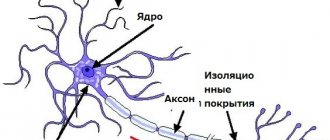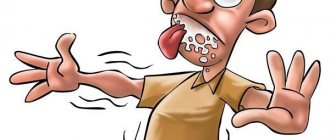Capgras syndrome (negative twin delusion) is a rare mental disorder. The patient is haunted by a feeling of anxiety; it seems to him that his loved ones have been replaced. Find the answer Are you having a problem? Enter “Symptom” or “Name of the disease” into the form, press Enter and you will find out all the treatment for this problem or disease.
The site provides reference information. Adequate diagnosis and treatment of the disease is possible under the supervision of a conscientious doctor. Any medications have contraindications. Consultation with a specialist is required, as well as detailed study of the instructions! Here you can make an appointment with a doctor.
A person suffering from such a disease often claims that he also has a double who commits certain actions (mostly bad).
Types of disease
These symptoms of Capgras syndrome are almost identical to another condition called delusion of the positive twin.
A person begins to recognize acquaintances, relatives and friends in complete strangers.
There are several types of syndrome:
- Autoscopic. When the patient asserts with complete confidence that there is a double in front of him.
- And the second type, when the presence of a double is invisible.
For the first time, the French psychiatrist Joseph Capgros managed to give a definition, somehow determine the symptoms and characteristics. The disease was named in his honor.
What is Capgras syndrome?
Each of the readers, at least once, having noticed someone similar to our acquaintance, tried to catch up with him, but having managed to do this, he realized that the person was unfamiliar to him. It is known that many famous people like Hitler had many doubles, but they looked for them in every nook and cranny and naturally this service was available only to the greatest of the living. In those days, she saved the lives of heads of state. Even now, the mystery of siblings is very fascinating; noticing such small, seemingly insignificant differences is incredibly interesting. What can we say about the surprise when two people without the slightest family ties meet and discover great similarities. Sure, plenty of people have some kind of sisterhood-type identity, but an exact copy is a rarity. This topic has been repeatedly raised in various works; even modern films are replete with similar plots. And this is not surprising, because it has the ability to attract more than the identity of two different people. Genetic engineering, which gives the ability to clone, is also touched upon to some extent. Undoubtedly, all these topics are bioethical and characteristic of all normal individuals.
But, unfortunately, this idea can develop into delusion. Capgras syndrome in psychiatry manifests itself as a similar group of disorders, the red thread of which is doubles. For a healthy individual, this delirium is very mysterious, which easily drags him into induced delusional production. It is not similar to other delusional species groups and carries a certain alien meaning with the replacement of people with someone alien, as it seems at first to individuals who are far from the realities of psychiatry. This view is formed without going deep into the study and without encountering the real situational aspects of the syndrome, because all the poetry and genius of the situation and reasoning very quickly dissipates with real individuals who have this pathology.
Capgras syndrome in psychiatry was identified in 1923. It is named after its founder, Joseph Capgras, who co-authored the syndrome in a psychiatric journal. This symptomatology did not immediately interest me; it was called the illusion of a double, which soon changed due to the incorrect use of the word illusion, which in this case does not describe the symptoms at all. It was believed that this syndrome was characteristic only of women, although it is difficult to say why now. Perhaps because patient zero was a woman who did not recognize her husband. Or maybe it’s because most male scientists worked in those days. But over time, the study was changed and it was realized that this pathology can be relevant not only as a psychiatric phenomenon, but also as a neurological one, since misrecognition can have many root causes, which can now be visualized in almost all cases.
Causes
No doctor or scientist can give a clear answer to what helps the development of such a disease.
A definite urge to pathology will be a severe head injury, which affects the functioning of important areas of the brain. At this moment, a person ceases to visually recognize objects and people, and false visions begin. Patients allegedly recognize complete strangers.
This is caused by an illusion, due to a violation of the integrity of brain activity in the most inappropriate area. Doctors identify damage to the frontal part of the brain, although when another area is injured, the chain of interaction is disrupted, which leads to the development of Capgras disease.
Overly emotional reactions to current events and experienced stress can contribute to the occurrence of this syndrome.
A small proportion of people begin to manifest this syndrome, the rest are simply in a state of mild (severe) form of depression, which goes away over some time.
Be that as it may, the syndrome begins its development on the basis of schizophrenia and other neurological disorders to which the person was exposed.
Notes
- Capgras, J. & Reboul-Lachaux, J. (1923). Illusion des sosies dans un delire systematise chronique. Bulletin de la Société Clinique de Medicine Mentale 2
6–16. - [www.ncbi.nlm.nih.gov/entrez/query.fcgi?cmd=Retrieve&db=PubMed&list_uids=11639277&dopt=Abstract Ellis, H. D.; Whitley, J.; & Luaute, J. P. (1994).] Delusional misidentification. The three original papers on the Capgras, Frégoli and intermetamorphosis delusions (Classic Text No. 17). History of Psychiatry 5
(17) 117–146. - Pimozide in the treatment of Capgras' syndrome. A case report. Psychosomatics 32
(4) 446–448. - Samokhvalov V.P.
[www.psyinst.ru/library.php?part=article&id=2062 Psychiatry] (Textbook for students of medical universities). - Phoenix, 2002. - 575 p. — ISBN 5-222-02133-5. - [www.ncbi.nlm.nih.gov/entrez/query.fcgi?cmd=Retrieve&db=PubMed&list_uids=1780403&dopt=Abstract Forstl, H.; Almeida, O.P.; Owen, A.M.; Burns, A.; & Howard, R. (1991).] Psychiatric, neurological and medical aspects of misidentification syndromes: a review of 260 cases. Psychological Medicine 21
(4) 905–910. - [www.ncbi.nlm.nih.gov:80/entrez/query.fcgi?cmd=Retrieve&db=PubMed&list_uids=11287268&dopt=Abstract Ellis, H. D. & Lewis, M. B. (2001).] Capgras delusion: a window on face recognition. Trends in Cognitive Sciences 5
(4) 149–156. - Ramachandran, V. S. (1999). Phantoms in the Brain: Probing the Mysteries of the Human Mind
. New York: Harper Collins Ltd. ISBN 0-688-17217-2 - Vilayanur S. Ramachandran.
The tell-tale brain. - Career Press LLC, 2011, edition in Russian, design, 2014. - pp. 80-82. — ISBN 978-5-00074-002-6.
Symptoms and clinical signs
The disease of mental illusions manifests itself in relation to people, less often objects.
Accompanied by the syndrome:
- Delirium, non-existent illusions;
- Hallucinations;
- Mental automatism.
Transitional states can be observed in patients, which allows us to distinguish many classifications of the disease. They will constantly argue furiously about the substitution of a person, without substantiating their point of view in any way, simply because it seemed so to them.
Patients do not use any logical thinking or action.
A person with the syndrome quickly forgets names and faces and gets lost in an area that has always been familiar to him. They do not lose their memory, but perceive everything that happens around them vaguely.
Another symptom is false recognition of people, even those whom the patient simply touched with his hand. It begins to seem to him as if they have known each other for many years, but are best friends.
One of the features of the diagnosis is that the patient may see one family member as a double, but they perceive the rest as usual. Why attention and aggression is focused on one character or another cannot be explained.
The reason will be recent conflicts or old grievances.
Housings
The following are some examples of reported cases of Capgras syndrome:
In one case, a man could not recognize his parents when he met them face to face. However, when talking to them on the phone, he recognized them without any problems.
In this case, it is possible that the disorder was caused by a gap between visualization and face recognition. Other recognition methods, such as voice recognition, were not affected.
In another case, a mother believed her daughter had been removed by child protective services and replaced by an impostor. The mother was diagnosed with Capgras syndrome and prescribed medication, but was unable to verify her daughter's identity.
Although cases of Capgras syndrome usually involve a close family member such as a surrogate spouse, parent, or sibling, cases involving children are rare. In the above case, the child was removed from the mother's care because there was a risk of violence against the “impostor.”
In the latest case, a 59-year-old man had been experiencing a variety of symptoms for several years, including impaired speech, anxiety and obsession with personal hygiene. He began to perceive his wife as a double and spend time searching for his “real” wife.
The man did not display anger or aggressive behavior, but claimed that his wife was a doppelgänger and addressed her in a dubious, curious tone. He recognized other people easily.
Comparison with Fregoli syndrome
Patients often exhibit Capgras and Fregoli syndrome (delirium of a positive double).
This name comes from the famous comedian Leopold Fregoli. When it seems to a person that facial changes are only partially occurring, they supposedly put on makeup or occasionally change their facial features. There is a certain split in the appearance of one or more relatives or friends. And the number of falsely recognized faces is reduced several times.
With Fregoli's symptom, the patient knows exactly the purpose of the double and its role in life. Sometimes it begins to seem to him that the character of the illusions is pursuing him.
Fregoli delirium is distinguished; this term came from one actor who was popular for his quick ability to change clothes and change images.
A person may feel that he is being stalked by actors whom he has constantly seen on the screen. These same people will be ordinary people you meet or relatives.
Treatment of Capgras syndrome
The relief of such disorders must be urgent, since the individual may pose a danger to others. Cupping requires an integrated approach with identification of the root causes. It is very important for such patients to limit access to a variety of faces, so as not to produce delusional production. The regime for such patients is gentle without unnecessary hassle, but always with occupational therapy, which puts stress on the muscles and relieves the brain of an excessive amount of unnecessary reasoning. If the cause is organic and after a stroke, then a neurosurgeon is required who can remove the problem. In some cases, neurological drugs are sufficient, but it still makes sense to treat psychotic symptoms with antipsychotics. Such individuals are shown a supervised hospital due to some danger to the environment. Socially, until complete relief from delusion, the individual is not functional, since he does not normally identify those around him. Depending on the reasons, communication with an individual with Capgras syndrome is structured differently. In the absence of criticism, we do not convince the individual, perceiving him as delusional.
Antipsychotics are relevant intramuscularly for at least two weeks, namely: Haloperidol, Aminazine, Clopixol, Monten, Tizercin, Triftazin, Truxal. Dosing should be individually selected, therapeutic with a gradual increase, taking into account concomitant disorders. Later, it is already possible to use different forms of the following drugs: Rispolept, Azapine, Azaleptol, Rispaxol consta, Clozapine, Solex, Serdolex, Risperidone, Solean, Ariprazole, Aripiprazole, Eglonil, Fluanxol.
The information presented in this article is intended for informational purposes only and cannot replace professional advice and qualified medical care. If you have the slightest suspicion that you have this disease, be sure to consult your doctor!








